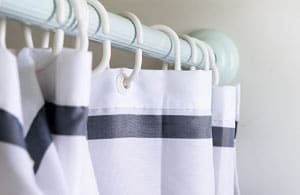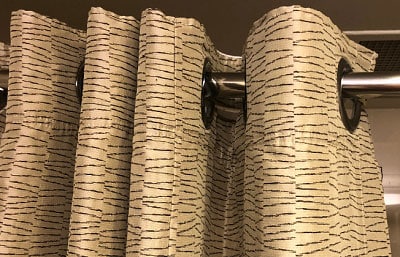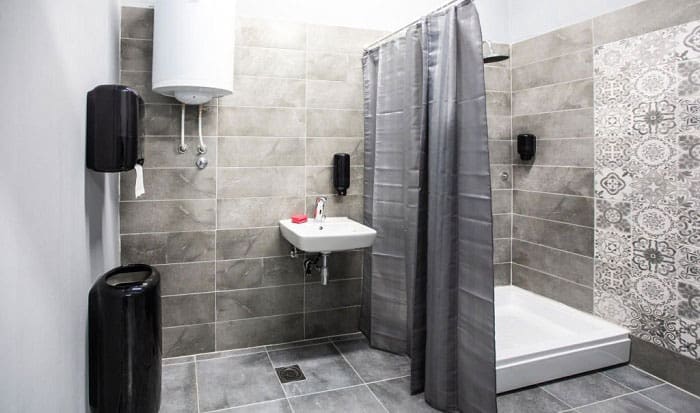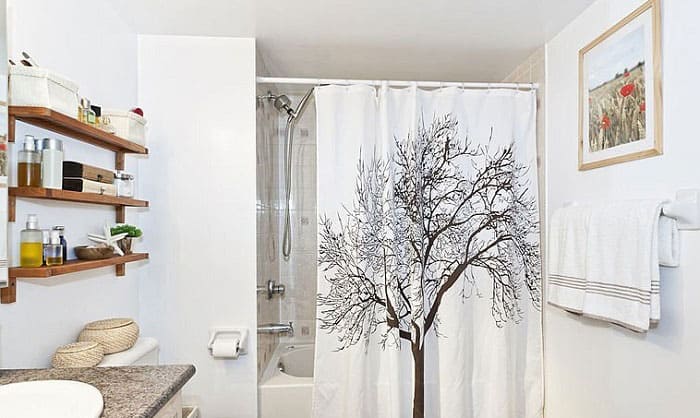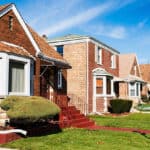One of the essential aspects of designing and setting up a practical bathroom is choosing the right shower curtains. These accessories, while seeming unimportant, are vital for providing a sense of privacy in the bathroom.
Then, do shower curtains need liners? Theoretically speaking, it’s possible to set up a shower curtain without the protective liner. However, this only applies to waterproof fabric; otherwise, frequent exposure to moisture will reduce the material’s lifespan.
So when is combining shower curtain with liner optional? Read on to find out.
Table of Contents
Can I Hang Shower Curtains Without Liners?
When is it okay to install a shower curtain no liner needed? The easiest way to tell is to examine its material. Waterproof shower curtains can be hung without a liner, although you’ll find that the protective layer can drastically reduce mildew growth on the fabric.
Let’s go over some common types of shower curtains and whether they’ll require waterproof shower liners.
1. Cotton
Although one of the most common choices for shower curtains, cotton is not waterproof unless it’s coated with a layer of hydrophobic spray. In most cases, though, the material doesn’t really fare well with constantly being exposed to humidity.
While some may say that cotton curtains don’t need liners due to their breathability and ease of maintenance, I’d beg to differ. For one thing, you may not have the time to regularly wash the curtains to keep them dry and clean all the time.
Another reason it’s essential to pair a PEVA liner with a shower curtain made of cotton is that this material actually absorbs a lot of water. Once damp, it’ll only take 1-2 days for mold and mildew to form on the fabric.
2. Polyester
To tell if a polyester shower curtain no liner required is appropriate, you’ll first need to examine whether it has a tight or open weave. If it’s the latter, then water may still pass through the fabric and drip all over your floor; a liner is necessary to prevent splashes.
However, if woven tightly enough and reinforced with a layer of hydrophobic coating, polyester shower curtains can be waterproof, meaning they don’t really need liners. To keep them clean, wash them on cold cycles with mild detergents every three months.
3. Microfiber
Like polyester, microfiber fabric can repel water, on the condition that it’s made from tight flat-woven threads. You can try pouring liquid directly over the material; if water doesn’t seep into the curtain, then yours is flat-woven and doesn’t need liners.
However, if the fabric does absorb water, it’s split-woven. Because the material is so absorbent that it can hold water 7 times its weight, this type of microfiber shower curtains need a liner.
4. PEVA
In case you are wondering, “Are PEVA fabric shower curtains waterproof?” then the answer is an absolute yes. This is because PEVA is technically plastic, making it one of the best choices when you need shower curtains that can repel splashes.
PEVA also has excellent resistance to mold and mildew in general. Although it’s not machine-washable, you can easily wipe it clean with the help of some baking soda. As such, using PEVA shower curtains with liners is not strictly necessary.
What Are Shower Curtain Liners?
1. Definition – what is the purpose of a shower curtain liner:
In short, a shower liner is an accessory to prevent water from splashing out of the tub while you shower. When paired with a curtain, it has the additional job of keeping the outside fabric from getting wet.
Considering how it needs to repel water, a shower liner material always needs to be waterproof. In addition, high-end products may also be designed to be resistant to mold and mildew, which otherwise are likely to thrive in such a humid environment.
Another telltale characteristic of shower liners is their weighted hem to ensure that the liner will stay put inside the tub when you shower. Note that this bathroom accessory must not be placed outside the tub, which will defeat its whole purpose of keeping the water contained.
2. Types
Based on their size, you can divide curtain liners into 5 main types: standard, shower stall, extra-tall, floor-to-ceiling, and extra-wide. Among these, only the second one is specifically made for shower stalls instead of bathtubs.
3. Material
As pointed out, it’s important to use shower curtain liner made from waterproof materials. Below are some popular choices:
- Vinyl: this is a budget-friendly choice that doesn’t sacrifice functionality. However, I wouldn’t recommend getting vinyl liners, considering that they contain potentially harmful compounds, such as phthalates.
- Polyester: unlike shower curtains made from the same material, polyester shower liners will feature a weighted bottom hem. It’s also safer than vinyl, but the material is also not entirely risk-free. For instance, it can trigger skin irritation.
- PEVA: compared to the two options above, PEVA liners are the safest. That said, they still contain traces of VOCs.
- Hemp: the best thing about this material is that it is PVC- and toxin-free, so it’ll pose less of a health risk. The fabric can air dry quickly and is relatively water-resistant. That said, it doesn’t repel water as well as PEVA.
4. Benefits of Liners
Why should you use shower curtain liner? For starters, liners will keep water from splashing all over your bathroom floor, which can pose a tripping hazard. A wet floor can also promote the growth of bacteria and unpleasant odors, which can affect the whole house.
What’s more, a liner will keep your shower curtain clean and prolong its lifespan. Without this protective barrier, a non-waterproof curtain can get damp and quickly develop mold or bad smells.
Tips to Choose a Good Liner
- Consider the material carefully. Do you prioritize resistance to water over potential exposure to toxins, or vice versa?
- Pick one with the correct size. It should be able to cover your bathtubs or shower stalls.
- Some liners are designed with extra resistance to mold, although they may also be more expensive.
- The liners should have weighted hems, suction cups, or magnets to stay put when you shower.
- Consider getting products with resilient grommets for better durability.
- Don’t overlook how the liner looks compared to your shower curtain and the rest of the bathroom. It should not seem out of place; instead, it needs to match your overall color scheme.
Frequently Asked Questions
Can you use a shower curtain without a liner?
You can, on the condition that the shower curtain is waterproof. If it’s not, the fabric will quickly get soaking wet when you shower. And if it doesn’t dry quickly enough, mold and mildew can develop on the fabric. In due time, the curtain will smell pretty bad as well.
What kind of shower curtains doesn’t need a liner?
The only type of shower curtains that don’t require a liner are ones that can repel water. This means only tightly-woven polyester, flat-woven microfiber, and PEVA shower curtains can be used without a protective layer.
That said, it’d still be helpful to use a liner with these materials, especially if you want to keep them clean and in tip-top shape for longer.
Shower liner vs shower curtain: what is the difference?
The distinguishing aspect between shower curtain vs liner is that the latter should be able to repel water, whereas it’s not always the case for the former.
In addition, a shower liner is always placed inside the tub; otherwise, it won’t be able to do its job properly.
A shower curtain, on the other hand, is recommended to be placed outside the tub (although there are exceptions, we’ll get to that later). After all, its main task is to provide privacy and decoration, not to prevent water splashing.
How often should I change my shower liner?
No matter how high-quality your shower liner is, it should be replaced twice a year at regular intervals. Although you can wash the accessory every two weeks to prolong the inevitable, sticking to the established recommendation is best, as mold and mildew can trigger allergic reactions in sensitive people.
Should I place the shower curtain inside or outside tub?
It depends. Is your shower curtain waterproof and not paired with a liner? If so, it’s best to place it inside; in this case, the curtain will also double-act as a liner, meaning it’ll prevent water from splashing outside.
However, if you pair shower curtains with liners, there’s no need to do so. Because they should also serve aesthetic purposes, you can hang the curtains however you want, as long as they look good.
Conclusion
Do shower curtains need liners? By now, you surely have learned the answer you need. Note that I personally recommend always going for a combo of a shower curtain and liner, as I like keeping my bathroom dry, clean, and mildew-free.
What about you? Will you skip the liner entirely if your shower curtain is waterproof? Share your thoughts with us in the comment below!
Related:

Hi, I am Roseanne Jones, an aspiring home designer that wants to make you feel more at home with your new house.With nearly five years of redecorating old residents and arranging new ones, I am confident that I can give you the best advice on your lovely place.




